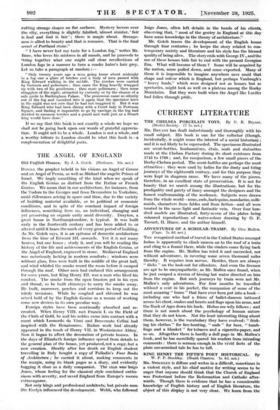THE ANGEL OF ENGLAND
Old English Houses. By J. A. Gotch. (Methuen. Ills. net.) DANIEL the prophet beheld in his visions an Angel of Greece and an Angel of Persia, as well as Michael the angelic Prince of Israel. We imply something of the kind when we speak of the English Genius as distinct from the Italian or French Genius. We mean that in our architecture, for instance, from the Tudors to the Georges and from Devonshire to Yorkshire, amid differences arising in space and time, due to the variety of building material available, or to political or economic conditions, and in spite of the constant impact of foreign influences, something lives on, an individual, changing and yet preserving an organic unity amid diversity. Drayton, a great house in Northamptonshire, is typical. It was built early in the fourteenth century and has been added to or altered until it bears the mark of every great period of building. As Mr. Gotch says, it is an epitome of domestic architecture from the time of Edward III. onwards. Yet it is not many hodses, but one house ; study it, and you will be reading the history of the life and achievements of the English Genius, or the Angel of England, engraved in stone. Mediaeval England was notoriously lacking in modern comforts ; windows were without glass, fires were built in the middle of the great hall, and wind whirled the smoke round the room before it escaped through the roof. Other men had endured this arrangement for some years, but King Henry 11I. was a man who liked his comfort. The smoke from the open brasiers got in his eyes and throat, so he built chimneys to carry the smoke away. He built, moreover, porches and corridors to keep out the windy invasions. While he coughed and shivered he was seized hold of by the English Genius as a means of working some new devices in its own peculiar way.
Foreign styles have been continually absorbed and re- created. When Henry VIII. met Francis 1. On the Field- of the Cloth of Gold, he and his nobles came into contact with a court which Leonardo. da Vinci and Benvenuto Cellini had inspired- -with the Renaissance. Italian work had already appeared in the tomb of Henry VII. in Westminster Abbey, Now it began to affect the decoration of private houses. In the days of Elizabeth foreign influence spread from details to the general plan of the house, yet produced,not a copy, but a new creation. Shortly after her death an English student travelling in Italy bought a copy of Palladio's Four Books of Architecture ; he carried it about, making comments in the margin, using its blank pages as a diary, and evidently hugging it close as a daily companion. The Man roils" Inigo Jones, whose feeling for the classical style combined enthu- siasm with severity, and saved England from Europe's rococo extravagance.
Not only kings and professional architects; but private men like Evelyn influenced the development. Webb, who followed Inigo Jones, often left details in the hands of his clients, observing that, " most of the gentry in England at this day have some knowledge in the theory of architecture." - Mr. Gotch traces the development of the English house through four centuries ; he keeps the story related to con- temporary society and literature and his style has the blessed quality of being alive. The story ends with George IV., and the use of these houses bids fair to end with the present Georgian Era. What will become of them ? Some will be acquired by the nation, some pulled down, and some exported. Many of them it is impossible to imagine anywhere save amid that shape and colour which is England, but perhaps Vanbrugh's " heavy loads," which were designed not as houses but as spectacles, might look as well on a plateau among the Rocky Mountains. But they were built when the Angel like Lucite/ had fallen through pride.






















































 Previous page
Previous page